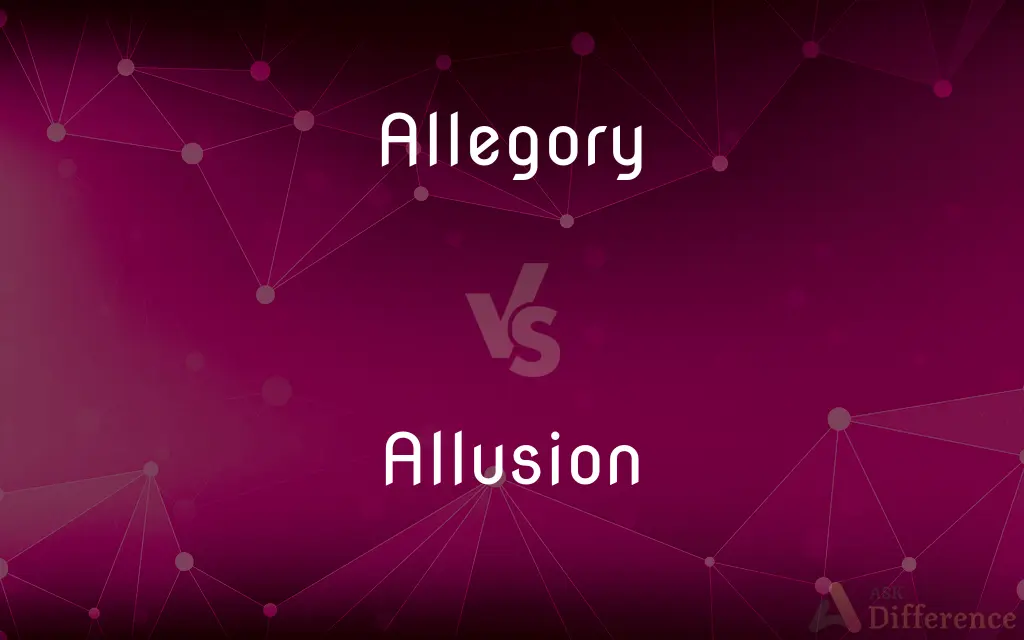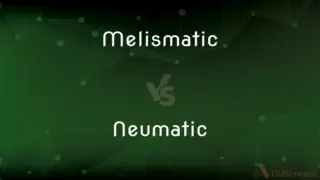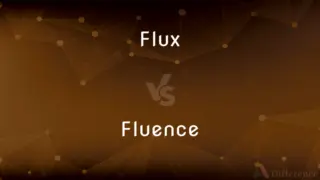Allegory vs. Allusion — What's the Difference?
By Urooj Arif & Maham Liaqat — Updated on March 27, 2024
Allegory is complete narrative that conveys abstract ideas to teach a moral lesson, where characters and events symbolize deeper meanings. Allusion is brief reference within a work to something outside it, hinting at knowledge shared with audience.

Difference Between Allegory and Allusion
Table of Contents
ADVERTISEMENT
Key Differences
Allegory uses extended metaphor throughout a work to convey complex ideas, beliefs, or moral questions, creating a parallel narrative that reflects real-life issues. Allusion, on the other hand, relies on the audience's familiarity with the referenced subject, be it historical, literary, or cultural, to add depth or context to the work without detailed explanation.
While an allegorical story is structured around a symbolic framework, intending the entire narrative to be interpreted for a deeper meaning, allusions are often fleeting, requiring only a momentary recognition or understanding from the audience. Allegories are used to explore and critique social, political, or moral concerns through a detailed symbolic narrative, whereas allusions enrich a text by drawing connections to other works or ideas, enhancing the reader's understanding through association.
An allegory demands a comprehensive construction of a parallel reality, where each element is meticulously designed to represent something else, often leading to multiple layers of meaning. Allusions, however, can be as simple as a single word or phrase that evokes a broader context, leaving much to the reader's interpretation and imagination without the necessity of elaboration.
The purpose of allegory often extends to teaching or illustrating a principle or truth, engaging the reader with a complex, coded story requiring interpretation to unveil its full significance. In contrast, the purpose of allusion is to evoke a specific mood, tone, or idea, leveraging the reader's existing knowledge to add layers or nuances to the primary narrative.
Allegorical works can stand alone, offering a self-contained universe with its own rules and symbolism, such as in George Orwell’s "Animal Farm". Allusions, however, depend on the existence of other texts or cultural knowledge for their full effect, enriching the primary work by linking it to broader themes or histories, such as the frequent biblical allusions in Western literature.
ADVERTISEMENT
Comparison Chart
Definition
A symbolic narrative with a deeper meaning, often moral or philosophical.
A brief reference to another work, event, or figure.
Purpose
To teach or illustrate a principle through symbolic storytelling.
To enrich a text by drawing connections to other works or ideas.
Usage
Constructs a parallel reality for exploration of complex ideas.
Relies on audience's knowledge for depth or context.
Narrative Scope
Entire work structured around symbolism.
Brief, often a single word or phrase.
Dependence
Can be self-contained with its own symbolism.
Depends on external references and the audience's familiarity.
Examples
"Animal Farm" by George Orwell, "The Pilgrim's Progress" by John Bunyan.
Biblical allusions in "The Waste Land" by T.S. Eliot, historical allusions in "Hamilton" by Lin-Manuel Miranda.
Compare with Definitions
Allegory
A story with a parallel, symbolic meaning.
The Lion, the Witch, and the Wardrobe is an allegory for Christian salvation.
Allusion
A brief reference to a person, place, thing, or idea of historical, cultural, literary, or political significance.
The novel's title, Brave New World, alludes to Shakespeare’s The Tempest.
Allegory
Utilizes characters and events as symbols.
In Animal Farm, the farm animals symbolize different factions in revolutionary Russia.
Allusion
Connects works across time and genre.
The song lyrics subtly allude to events from the civil rights movement.
Allegory
Often moral or philosophical.
Plato’s allegory of the cave examines reality and enlightenment.
Allusion
Enhances meaning through familiarity.
The poem’s mention of Icarus alludes to the dangers of ambition.
Allegory
Teaches through coded storytelling.
The Pilgrim's Progress allegorizes the Christian journey of faith.
Allusion
Requires knowledge for full appreciation.
His speech included an allusion to a famous line from Martin Luther King Jr.
Allegory
Explores broader themes through narrative.
Lord of the Flies uses stranded children to explore human nature and society.
Allusion
Adds depth with minimal exposition.
The mention of Pandora's box serves as an allusion to unforeseen consequences.
Allegory
As a literary device, an allegory is a narrative in which a character, place, or event is used to deliver a broader message about real-world issues and occurrences. Authors have used allegory throughout history in all forms of art to illustrate or convey complex ideas and concepts in ways that are comprehensible or striking to its viewers, readers, or listeners.
Allusion
Allusion is a figure of speech, in which an object or circumstance from unrelated context is referred to covertly or indirectly. It is left to the audience to make the direct connection.
Allegory
A story, poem, or picture that can be interpreted to reveal a hidden meaning, typically a moral or political one
Pilgrim's Progress is an allegory of the spiritual journey
Allusion
An expression designed to call something to mind without mentioning it explicitly; an indirect or passing reference
A classical allusion
An allusion to Shakespeare
Allegory
The representation of abstract ideas or principles by characters, figures, or events in narrative, dramatic, or pictorial form.
Allusion
The act of alluding; indirect reference
Without naming names, the candidate criticized the national leaders by allusion.
Allegory
A story, picture, or play employing such representation. John Bunyan's Pilgrim's Progress and Herman Melville's Moby-Dick are allegories.
Allusion
An instance of indirect reference
An allusion to classical mythology in a poem.
Allegory
A symbolic representation
The blindfolded figure with scales is an allegory of justice.
Allusion
An indirect reference; a hint; a reference to something supposed to be known, but not explicitly mentioned
Allegory
(rhetoric) A narrative in which a character, place, or event is used to deliver a broader message about real-world issues and occurrences.
Allusion
A figurative or symbolical reference.
Allegory
A picture, book, or other form of communication using such representation.
Allusion
A reference to something supposed to be known, but not explicitly mentioned; a covert indication; indirect reference; a hint.
Allegory
A symbolic representation which can be interpreted to reveal a hidden meaning, usually a moral or political one.
Allusion
Passing reference or indirect mention
Allegory
A category that retains some of the structure of the category of binary relations between sets, representing a high-level generalisation of that category.
Allegory
A figurative sentence or discourse, in which the principal subject is described by another subject resembling it in its properties and circumstances. The real subject is thus kept out of view, and we are left to collect the intentions of the writer or speaker by the resemblance of the secondary to the primary subject.
Allegory
Anything which represents by suggestive resemblance; an emblem.
Allegory
A figure representation which has a meaning beyond notion directly conveyed by the object painted or sculptured.
Allegory
A short moral story (often with animal characters)
Allegory
A visible symbol representing an abstract idea
Allegory
An expressive style that uses fictional characters and events to describe some subject by suggestive resemblances; an extended metaphor
Common Curiosities
Can a work of literature be both allegorical and contain allusions?
Yes, many works of literature employ both techniques, using allegory to construct a deeper narrative framework and allusions to add contextual layers.
Can allegory exist outside literature?
Yes, allegory can be found in various forms of art, including painting, film, and theatre, wherever symbolic representation conveys deeper meanings.
What is an allusion?
An allusion is a brief and indirect reference to a person, place, thing, or idea of significance, enhancing the primary work by drawing upon the audience's existing knowledge.
Why do authors use allusions?
Authors use allusions to connect their work to broader themes, enhance its meaning, or evoke specific emotions by drawing on the audience's prior knowledge.
What is an allegory?
An allegory is a symbolic narrative in which characters and events represent broader themes, often moral or philosophical, designed to convey deeper meanings.
How does one identify an allegory?
Identifying an allegory involves recognizing consistent symbolism throughout the work that correlates with real-life issues, themes, or moral lessons.
Are allusions always easy to recognize?
Recognizing allusions may require specific cultural, historical, or literary knowledge, making some allusions more accessible to certain audiences than others.
How do allegories and allusions differ in their storytelling approach?
Allegories create a parallel symbolic world requiring interpretation, while allusions rely on brief references to enrich a story without elaborate explanation.
How do allusions contribute to a reader’s experience?
Allusions can deepen the reader's engagement with the text by prompting connections to other works, encouraging a more active and reflective reading experience.
What makes an allegory effective?
An effective allegory seamlessly integrates symbolic elements with the narrative, allowing for multiple levels of interpretation and insight.
Share Your Discovery

Previous Comparison
Melismatic vs. Neumatic
Next Comparison
Flux vs. FluenceAuthor Spotlight
Written by
Urooj ArifUrooj is a skilled content writer at Ask Difference, known for her exceptional ability to simplify complex topics into engaging and informative content. With a passion for research and a flair for clear, concise writing, she consistently delivers articles that resonate with our diverse audience.
Co-written by
Maham Liaqat















































